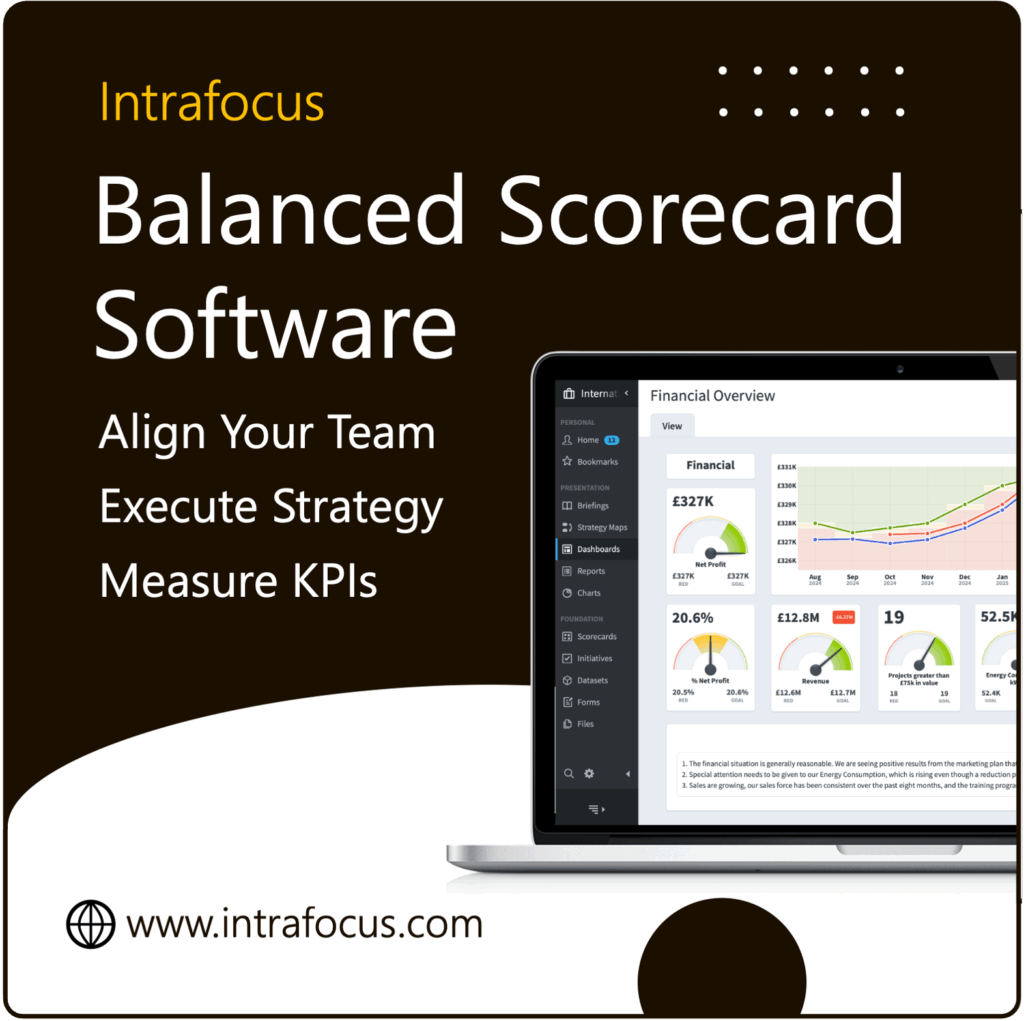The Balanced Scorecard is a strategic management tool that has revolutionised how organisations plan, implement, and monitor their strategies. Developed by Robert Kaplan and David Norton in the early 1990s, it goes beyond traditional financial metrics to provide a more comprehensive view of an organisation’s performance. It incorporates four perspectives: Financial, Customer, Internal Processes, and Organisational Capacity. This holistic approach helps organisations align their activities with their vision and strategy, improve internal and external communications, and monitor performance against strategic goals.
This article delves into real-world success stories of companies using the Balanced Scorecard to improve their performance significantly. By examining these examples, we aim to provide valuable insights and practical lessons that readily apply to other organisations looking to enhance their strategic management practices. Whether you are new to the concept or looking to refine your current strategy, these stories will demonstrate the power and versatility of the Balanced Scorecard in driving organisational success.
Balanced Scorecard Success Stories
Companies worldwide have adopted the Balanced Scorecard, which has helped them achieve remarkable success. The following examples show how this tool can make a real difference.
1. Apple Inc.
Apple, the tech giant, is one of the most famous examples of successful Balanced Scorecard implementation. Faced with stiff competition and the need for constant innovation, Apple used the Balanced Scorecard to align its product development with customer needs and financial goals. Focusing on customer satisfaction, internal processes, and employee learning improved Apple’s product quality. It maintained its market leadership, helping it stay ahead in the highly competitive tech industry.
2. Hilton Hotels
Hilton Hotels, a leader in the hospitality industry, used the Balanced Scorecard to enhance its customer service and operational efficiency. By tracking key metrics such as guest satisfaction, employee training, and internal processes, Hilton was able to identify areas for improvement and implement effective strategies. The result was improved customer experiences, higher employee morale, and increased profitability. This success story highlights how the Balanced Scorecard can be used to deliver exceptional service and achieve business goals.
3. Ford Motor Company
Ford, a major player in the automotive industry, adopted the Balanced Scorecard to streamline its operations and improve financial performance. Focusing on financial metrics, customer feedback, internal processes, and employee development enhanced product quality and reduced costs. This holistic approach helped Ford overcome significant challenges and become a stronger, more competitive company. Ford’s experience shows how the Balanced Scorecard can drive operational excellence and financial success.
4. Tesco
A leading retail chain, Tesco implemented the Balanced Scorecard to better understand and meet customer needs. Tesco improved its service, streamlined operations, and increased profitability by focusing on customer satisfaction, internal processes, financial performance, and learning and growth. This comprehensive approach helped Tesco maintain its position as a market leader in the retail industry.
These examples from Apple, Hilton, Ford, and Tesco demonstrate the versatility and effectiveness of the Balanced Scorecard. These companies achieved significant improvements and maintained their competitive edge by focusing on key metrics across different perspectives. These success stories highlight the potential of the Balanced Scorecard to transform organisations and drive strategic success.
Key Metrics and Outcomes
When companies adopt the Balanced Scorecard, they focus on specific metrics across the four perspectives: Financial, Customer, Internal Processes, and Learning & Growth. Here, we look at the key metrics and outcomes Apple, Hilton, Ford, and Tesco achieved.
1. Apple Inc.
- Customer Perspective: Apple tracked customer satisfaction and loyalty. Metrics like Net Promoter Score (NPS) and customer retention rates helped Apple understand customer preferences and improve product features.
- Financial Perspective: Apple focused on revenue growth, profit margins, and return on investment (ROI). These metrics allowed Apple to manage its financial health while investing in innovation.
- Outcome: By aligning products with customer needs and maintaining strong financial management, Apple continued releasing popular products and saw significant revenue growth and expansion of market share.
2. Hilton Hotels
- Customer Perspective: Hilton monitored guest satisfaction scores and repeat visit rates. Understanding guest preferences enabled Hilton to tailor services and enhance guest experiences.
- Internal Processes Perspective: Hilton tracked efficiency metrics like check-in/check-out times and room turnaround times. Improving these processes increased operational efficiency.
- Outcome: With better customer service and streamlined operations, Hilton achieved higher guest satisfaction, improved employee morale, and increased profitability.
3. Ford Motor Company
- Internal Processes Perspective: Ford focused on production efficiency, quality control, and innovation. Metrics such as defect rates and production cycle times were critical.
- Organisational Capacity Perspective: Employee training and development were prioritised. Metrics included training hours per employee and innovation project counts.
- Outcome: Ford improved product quality and reduced manufacturing costs. Enhanced employee skills and innovation led to better-designed vehicles and higher customer satisfaction.
4. Tesco
- Customer Perspective: Tesco monitored customer satisfaction, loyalty, and market share. Metrics like customer feedback scores and shopping frequency provided insights.
- Financial Perspective: Tesco focused on sales growth, profit margins, and cost control. Financial metrics helped Tesco manage expenses while increasing revenue.
- Outcome: By better understanding customer needs and managing finances effectively, Tesco improved service quality, operational efficiency, and profitability, solidifying its market leadership.
These metrics across the four perspectives of the Balanced Scorecard enabled Apple, Hilton, Ford, and Tesco to achieve substantial improvements. Focusing on customer satisfaction, internal processes, financial performance, and organisational capacity, these companies addressed their immediate challenges and positioned themselves for long-term success. These outcomes underscore the Balanced Scorecard’s power in driving comprehensive organisational improvement.
Case Study: Manuafacturing.com
A compelling success story can be built by taking aspects of multiple successes to make a case. In this instance, we have created a company called Manufacturing.com. This global manufacturing firm faced significant market competitiveness and operational efficiency challenges. This case study will detail their journey with the Balanced Scorecard, highlighting their challenges, the implementation process, and the remarkable improvements they experienced.
Challenges Faced
Manufacturing.com struggled with several issues, including declining market share, rising operational costs, and low employee morale. Their traditional focus on financial metrics alone was insufficient to address these challenges. They needed a more comprehensive approach to align their strategic objectives with day-to-day operations and improve overall performance.
Implementation Process
To address these challenges, Manufacturing.com decided to implement the Balanced Scorecard. The process began with senior management identifying the key strategic goals for the company. They then translated these goals into specific objectives across the four Balanced Scorecard perspectives:
- Financial Perspective: Improve cost efficiency and increase profitability.
- Customer Perspective: Enhance customer satisfaction and loyalty.
- Internal Processes Perspective: Streamline manufacturing processes and reduce waste.
- Organisational Capacity Perspective: Invest in employee training and development to foster innovation.
Manufacturing.com involved key stakeholders from various departments to ensure a comprehensive and inclusive approach. They conducted workshops to educate employees about the Balanced Scorecard and its benefits. This involvement helped gain company-wide buy-in and align everyone towards common goals.
Significant Improvements
With the Balanced Scorecard in place, Manufacturing.com started to see improvements in several areas:
- Financial Perspective: By focusing on cost efficiency, Manufacturing.com reduced operational costs by 15% within the first year, and profit margins improved significantly.
- Customer Perspective: Customer satisfaction scores increased by 20%, thanks to targeted initiatives based on customer feedback and improved product quality.
- Internal Processes Perspective: Streamlining manufacturing processes reduced production cycle times by 25% and waste by 30%, boosting overall productivity.
- Organisational Capacity Perspective: Employee training programs resulted in a 40% increase in innovation project submissions. This enhanced the company’s product offerings and boosted employee morale and engagement.
Outcome
Implementing the Balanced Scorecard transformed Manufacturing.com. By aligning their strategic goals with measurable objectives and involving employees at all levels, they could overcome their challenges and substantially improve. The Balanced Scorecard provided a clear framework for tracking progress and making data-driven decisions, leading to sustainable growth and long-term success.
Manufacturing.com’s experience demonstrates the effectiveness of the Balanced Scorecard in driving comprehensive organisational improvement.
Lessons Learned
The success stories of companies like Apple, Hilton, Ford, Tesco, and Manufacturing.com reveal several valuable lessons for organisations looking to implement the Balanced Scorecard. Here are the key takeaways:
1. Comprehensive Approach
One of the most important lessons is the need for a comprehensive approach. The Balanced Scorecard’s four perspectives—Financial, Customer, Internal Processes, and Organisational Capacity—must all be considered to gain a holistic view of the organisation’s performance. Focusing solely on financial metrics is insufficient; companies must prioritise customer satisfaction, operational efficiency, and employee development.
2. Clear Objectives and Metrics
Setting clear, measurable objectives is crucial. Organisations must define specific goals for each perspective and identify the metrics that will be used to track progress. For example, customer satisfaction can be measured using Net Promoter Scores (NPS) and retention rates. At the same time, financial health can be tracked through profit margins and revenue growth. Clear objectives and metrics ensure everyone understands what success looks like and how it will be measured.
3. Stakeholder Engagement
Engaging key stakeholders throughout the implementation process is essential. Involving employees at all levels helps to gain buy-in and align the organisation towards common goals. Workshops, training sessions, and regular communication can help ensure everyone understands the Balanced Scorecard and their role in its success. This engagement fosters a sense of ownership and accountability across the organisation.
4. Adaptability and Flexibility
The Balanced Scorecard is not a static tool; it requires continuous monitoring and adaptation. Companies must be willing to adjust their strategies and metrics as needed to respond to changing market conditions and internal challenges. Regular reviews and updates ensure that the Balanced Scorecard remains relevant and effective in guiding the organisation towards its strategic goals.
5. Data-Driven Decision Making
Successful implementation of the Balanced Scorecard involves leveraging data to drive decision-making. Organisations must collect and analyse data from various sources to track performance against objectives. This data-driven approach helps identify areas for improvement, validate strategies, and make informed decisions that support long-term success.
6. Focus on Continuous Improvement
Finally, the Balanced Scorecard encourages a culture of continuous improvement. By regularly reviewing performance and seeking ways to enhance processes, products, and services, organisations can maintain their competitive edge and drive ongoing success. This focus on continuous improvement helps companies adapt to new challenges and seize growth opportunities.
A Transformative Tool
The Balanced Scorecard has proven to be a transformative tool for organisations across various industries, from technology and hospitality to manufacturing and retail. The success stories of Apple, Hilton, Ford, Tesco, and Company A demonstrate the powerful impact of this strategic management framework. By incorporating the four perspectives—Financial, Customer, Internal Processes, and Organisational Capacity—these companies achieved comprehensive improvements and sustained long-term success.
These real-world examples highlight several crucial lessons:
- The importance of a holistic approach
- Setting clear and measurable objectives
- Engaging stakeholders
- Maintaining adaptability
- Leveraging data for informed decision-making
- Fostering a culture of continuous improvement
These elements played a vital role in successfully implementing the Balanced Scorecard, enabling organisations to align their activities with their strategic goals and drive performance.
The Balanced Scorecard’s versatility makes it an invaluable tool for any organisation seeking to enhance its strategic management practices. Whether you are in the early stages of implementation or looking to refine your existing strategy, the insights gained from these success stories can guide you toward strategic excellence. Adopting the Balanced Scorecard allows your organisation to better navigate challenges, capitalise on opportunities, and achieve sustained growth and success.



